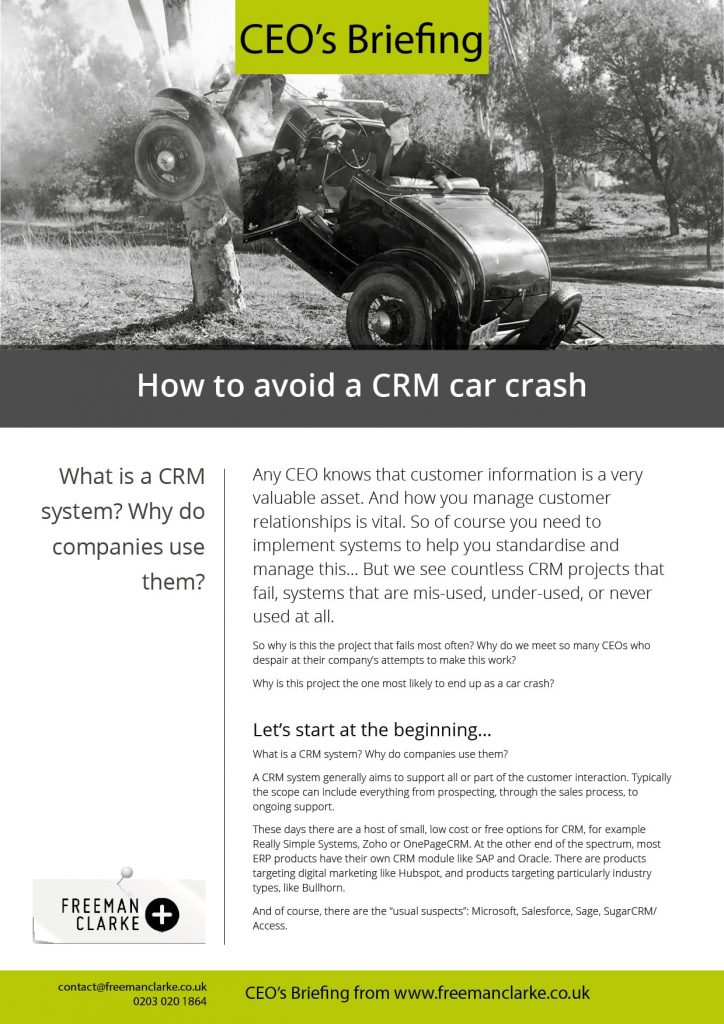How to Avoid a CRM Car Crash
Every CEO knows that customer information is a crucial asset. And how you manage customer relationships is vital. So of course you need to implement systems to help you standardize and manage Customer Relationship Management (CRM). Unfortunately, we’ve see countless CRM projects that fail, or CRM systems that are misused, underused, or never used at all.
So why is CRM a project that fails so often?

CEO's Briefing - How to avoid a CRM car crash
To find out how to swerve away from a CRM car crash download our latest CEO's briefing!
Download now for FREE!This CEO’s Briefing explains the basics of CRM systems and why companies need them. It also presents the ten rules for avoiding a CRM project car crash.
Let’s start at the beginning…
What Is a CRM System? And Why Do Companies Use Them?
A CRM system aims to support all or part of the customer interaction. Typically the scope can include everything from prospecting, through the sales process, to ongoing support.
These days there are a host of small, low-cost or free options for CRM, such as Really Simple Systems, Zoho, or OnePageCRM. At the other end of the spectrum, most Enterprise Resource Planning (ERP) products, like SAP and Oracle, have their own CRM module.
There are products targeting digital marketing like Hubspot, and products targeting particular industries like Bullhorn. And of course, there are the usual suspects: Microsoft, Salesforce, Sage, and Sugar CRM/Access.
These products and their heavily incentivized salespeople generally promise the following:
• Standardized processes
• Support for complex marketing campaigns
• All data in one secure place
• Improved reporting on different channels, products, markets and individuals
• Eliminated dependence on key personnel
• Increased focus and responsiveness for customer-facing staff
• Integration of systems and processes to avoid errors and redundancies
So all you have to do is choose the best product for your company. It’s all pretty straightforward, right?
So Why Do CRM Implementations So Often Go Wrong?
There are two primary causes of a CRM car crash:
People issues. Systems are built by people and for people, and the most common cause of failure is people.
Complexity. As a project progresses, a clear vision gradually becomes overcomplicated. This leads to cost overruns, unresolved process or data issues, or a system that users find too difficult to operate.
Of course, these two issues aren’t unique to CRM. But in CRM systems they combine to form a toxic mix.
What Are the People Issues?
Sales people are notorious for their thick skin. This is no accident, as we often recruit them for this trait. We often want sales people to be single-minded — in fact, many organizations forgive or even expect some selfishness. It’s part of the traditional sales culture. Observance of rules and process, attention to details and admin are not.
And, from the salesman’s point of view, the benefits of a CRM may be for the rest of the organization or for the management.
Often central administrative staff and management define the system in order that it collects data they want for reporting and analysis, but the burden of collecting this falls on front-line staff who see no benefit themselves.
Many users of the CRM system may be thinking: “There’s no benefit for me in this CRM thing.” They pretend to be onboard, but really they’re not.
And where does the complexity come from?
There are three underlying sources of complexity.
First, the scope of a CRM system may be unclear at the beginning, and as the project progresses it is tempting to expand it. Many CRM products are extremely flexible, so they can be configured to support a huge range of activities — they can manage workflow, provide a framework for task management, create announcements and reminders, and integrate with other systems.
But all these features can get overcomplicated, especially if you need multiple internal experts and suppliers. And none of these add-ons come without a price.
Second, like any systems implementation, the focus needs to be on improving and automating the process in question, rather than continuing the same inefficiencies with new technology. This means confronting difficult questions about how and why things are done a certain way, and dealing with organizational questions that may be creating hurdles to change.
Finally, most organizations have 80/20 rules — in other words, most of the business is comprised of standardized products and processes, but a minority of business is done differently. Perhaps there is a longstanding sideline of bespoke products; perhaps some high-value customers get special service. This twenty percent can bring complexity to the entire system.
To continue reading, download the article above.
Visit our ERP and Integration Issues Knowledge Center which includes all content related to this topic.